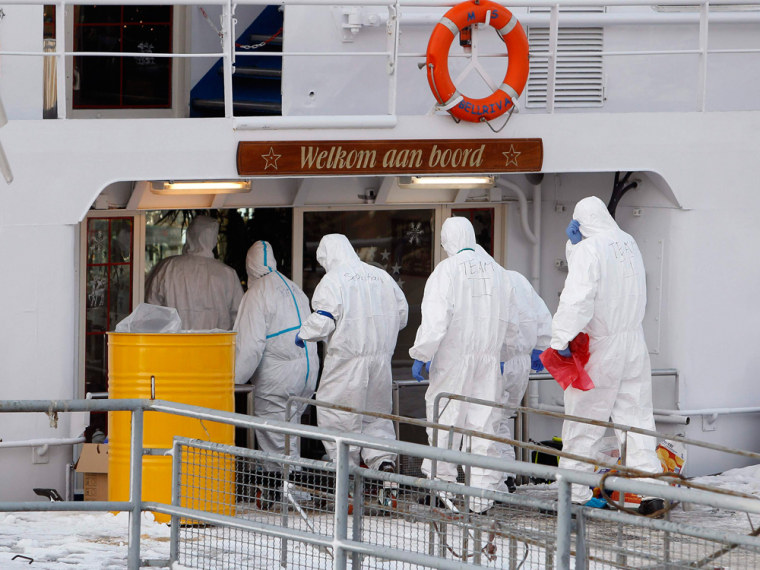It gets in your food, in your laundry, it sticks to plates and it might even float into the air when you flush your toilet. A new strain of norovirus -- often called stomach flu -- is going around and it’s going to be very hard to avoid it, experts say.
Federal health officials say a new strain, called the Sydney strain, is now causing most of the misery across the United States and the world. The virus, sometimes known as Norwalk virus or winter vomiting disease, causes vomiting, diarrhea and that someone-just-hit-me-with-a-plank feeling.
There’s no real treatment for it except for waiting it out, no vaccine, and recent studies show it’s one of the hardest viruses to get rid of. Simple cleaning alone doesn’t always kill it, and it takes just a few particles of virus to sicken a person.
“It is pretty difficult to get rid of,” says Allison Aiello, who studies how viruses spread at the University of Michigan. “It is pretty stable. It lives quite some time on surfaces. It is hard to kill.”
For instance, a few recent studies show that a quick application of hand sanitizer won’t get rid of it, Aiello says. And most people don’t wash their hands properly, either -- it takes about 30 seconds of vigorous rubbing using hot water and soap to wash away the tiny bits of virus, and that means getting under the nails, too.
Perhaps worst of all, people start spreading norovirus before they actually feel sick, and they can spread it for as long as two weeks after they start getting better.
“Imagine you have a food handler who uses the bathroom and they haven’t washed their hands thoroughly,” Aiello said in a telephone interview. “They can end up preparing a salad for the diners that evening and end up infecting a lot of people because the food isn’t cooked. You can’t really do anything about that.”
Raw shellfish is a notorious source of norovirus and other foodborne germs, but at least one recent study suggests norovirus may be even more insidious than that. In December, a team at Ohio State University found the virus stuck to plates that had been washed in restaurant-like conditions -- and they found sticky dairy products like cheese helped the virus stay there.
Hand-washed dishes are especially likely to carry the virus, the Centers for Disease Control and Prevention says in its website -- which could be one reason norovirus causes so many outbreaks on cruise ships. “You cannot get the water hot enough if you wash by hand,” says Aiello.
Norovirus is spread fecally -- in the poop -- and that means it can get into laundry. Studies show that fecal matter spreads even in ordinary laundry, so if someone is sick, it’s important to use very hot water and bleach to destroy virus that could be on any clothing, sheets or towels.
And regular cleaner won’t get the virus off surfaces. CDC recommends using bleach, including chlorine bleach or hydrogen peroxide.
Complicating the problem, most restaurant workers don’t get paid sick leave, so if they miss work, they don’t get paid. This means many workers come in sick, and they can spread the virus to hundreds of customers. Food handlers, dishwashers, even staff who bus and clear tables, all can spread the germ.
“If they have to go back to work there has to be complete and utter vigilance about washing your hands,” Aiello says.
In June, the Food Chain Workers Alliance issued a report showing that only 21 percent of workers surveyed could take a paid sick day off work. More than half said they come to work sick because they cannot take time off.
The problem extends to the home, too. There, Aiello said, several factors make it hard to keep one sick family member from infecting others.
“It could be the door handle. It could be the toilet tank cover. Some studies show it can be aerosolized. If you throw up and then flush the toilet, how much of the spray gets into the air?” she asked. One study last year showed how the virus spread on a plastic bag that had been in a bathroom where a norovirus patient threw up.
Norovirus is the most common cause of acute gastroenteritis -- stomach upset -- in the United States. It makes 21 million people sick every year in the United States – 70,000 on average sick enough to go to the hospital. As many as 800 people die, mostly elderly patients who become dehydrated. It’s the the most common cause of foodborne-disease outbreaks, CDC says.
Dr. John Treanor of the University of Rochester Medical Center in New York is working on a vaccine against norovirus. But the same properties that make norovirus so hard to kill also make it hard to make a vaccine.
For one thing, it’s simple. Like all viruses, norovirus hijacks live cells, turning them into virus factories that kick out particles called virions. “There is only one protein they use to make virions,” Treanor says. “If you have that one protein, it will self-assemble.”
The virus is also surrounded by a case called a capsid, which makes it hard to kill. The viruses infect the epithelial cells which line the digestive tract, causing cramps, diarrhea and vomiting, but it’s not understood exactly why.
And the virus mutates. “You typically see a specific strain, and then that strain is replaced by a new strain,” Treanor said. In this case, a strain called New Orleans has been replaced by the Sydney strain. Like with influenza, people who may have had some immunity against one strain aren’t protected agaisnt the new one.
So until there is a vaccine, what can people do? “There really isn’t very much you can do,” says Treanor. “Clearly, washing your hands is important.”
Related stories:
